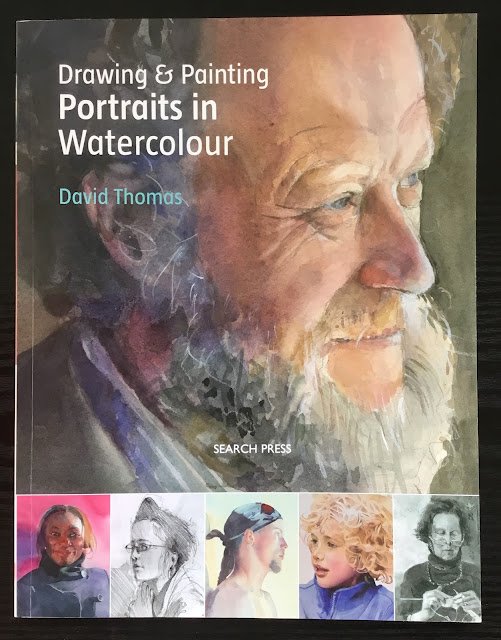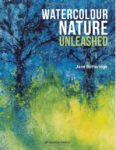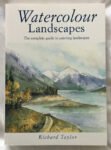This book keeps popping up on my Amazon recommendations. When I took a look inside,…

Drawing & Painting Portraits In Watercolour, David Thomas – Book Review
Another book review and this time it’s a foray into the world of watercolour portraits, surely a direction that I’ll be travelling at some point in the near future. This 128 page paperback was the only book out there on this subject for a long time and generally gets good reviews and it’s been on my wishlist for a while, so let’s see how it goes.
We start with ten pages of introduction, including a list of materials. Not a great start to be honest. A book on painting portraits isn’t going to be anybody’s first book, so we’re already wasting trees.
Then we have 25 pages on design. So that’s things like lighting, pose and choice of background as well as composition. There wasn’t really anything here that I didn’t know and what should have been 10 pages of advice is spread out over a whopping 25 pages by David showing some of his paintings as examples. Let’s move on.
We then have 20 pages on “using line”. We’re encouraged to go out sketching, shown some of David’s sketches, given some vague advice on photos and taken through a couple of demonstrations, one with graphite pencil and one with charcoal. Still no use of watercolour and we’re up to page 57.
Ah, here we go, a chapter on watercolour about 25 pages long. Most of this chapter is really basic stuff. How to put down a wash, how to blend colours on the paper, how to use masking fluid, colour temperatures, colour wheels. Like I said earlier, no beginner is going to be buying this book. What a waste of paper. Then towards the end of the chapter we get some woolly demonstration of painting from life or from photos and a few examples of David’s work that don’t really add anything apart from providing inspiration. Commentary along the lines of “This portrait is based on a tiny bit of a much bigger photo that I blew up, so I only had something pretty blurry to work from.” doesn’t teach me anything.
We then get eight pages on hair, eyes, hands and age. The sort of thing I was hoping to see covered much more extensively. And there’s very little advice here. We’re told to observe the subject carefully and not much more than that.
And we finish off with three demonstrations of the paint-along-with-me variety, with David even encouraging the reader to copy his portraits. The demos are broken down into loads of different steps and are like knitting patterns, telling us exactly which colours and brushes to use in every step. But it’s all how and no why. Why are we using these particular colours? Why are we reaching for cerulean blue at this point? Why are you telling us to strengthen the shadows on the neck at this point? Is it because you looked at your painting and saw that the colour wasn’t strong enough? Is it possible that my colour might already be strong enough and not need this extra layer? Give us some answers, man!
I have two more complaints about that final chapter:
– there’s a reference to stumbling on watercolour paint. What does this mean? It’s not something that was explained earlier when we were being talked to as if we’d never picked up a brush before
– and the quality of the paintings in these demos isn’t great. I think David knows this because that’s the only reason I can think of for him redoing all three and showing us both finished versions in all three cases.
What about the voice and the inspiration? The voice didn’t really come through. I didn’t detect much passion and felt as it I was being talked down to a lot of the time. Inspiration-wise there’s a lot of very good work in here but it’s stuff that I don’t feel any closer to being able to paint than I did before I read the book.
So, yeah, not great. For portraiture in any medium I’d recommend going for the William Maughan book and, if wanting to do portraits in watercolour, supplementing this with either Painting By Design or The Natural Way To Paint by Charles Reid, both of which include far more advice on watercolour portraits than you’ll find here, including much better explanations of how to mix flesh tones. Of the two Charles Reid books, The Natural Way To Paint is the more people focused, even if it covers figures as well as portraits. There are a couple of new books coming out in 2023 on watercolour portraits that I’m hoping I can learn more from and these have both gone onto my Amazon List.
This, for me, is an easy one palette. I feel angry just writing up this review. If you want to read a calmer and more polite review (albeit one along very similar lines), check out this one by Theo Yi Chie.
🎨
<Edit: Hiroko Shibasaki has written a great book on watercolour portraits of you like to paint using realistic colours
and Liz Chaderton’s book would make a great complement to the Bill Maughan book if you prefer to paint impressionistically.>
You can find this book and more reviews of it at Amazon UK here. As an Amazon Associate, I earn commission from qualifying purchases but this costs absolutely nothing extra to you.








Leave a Reply